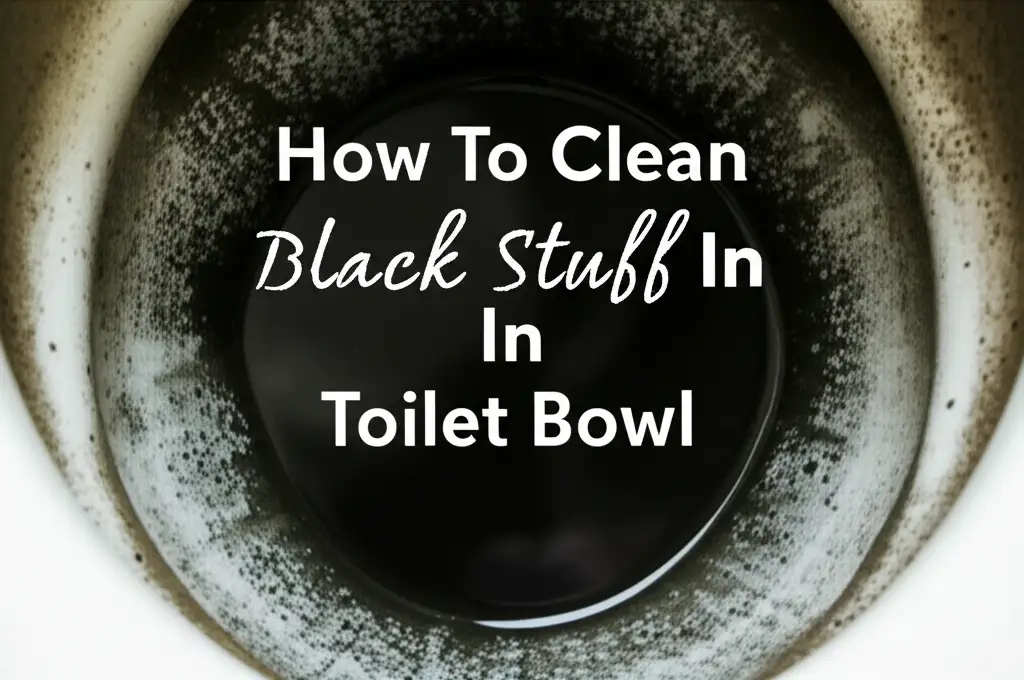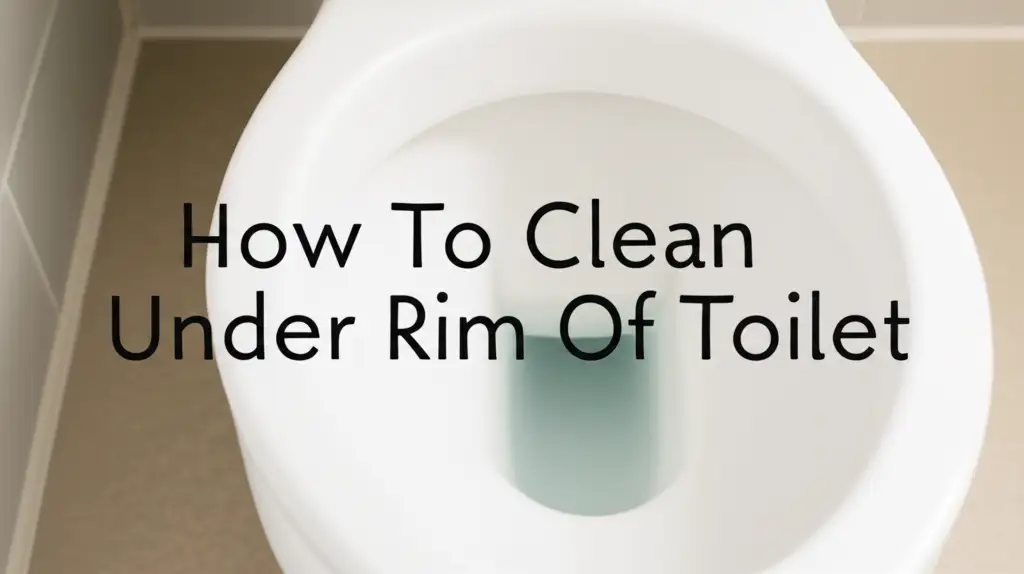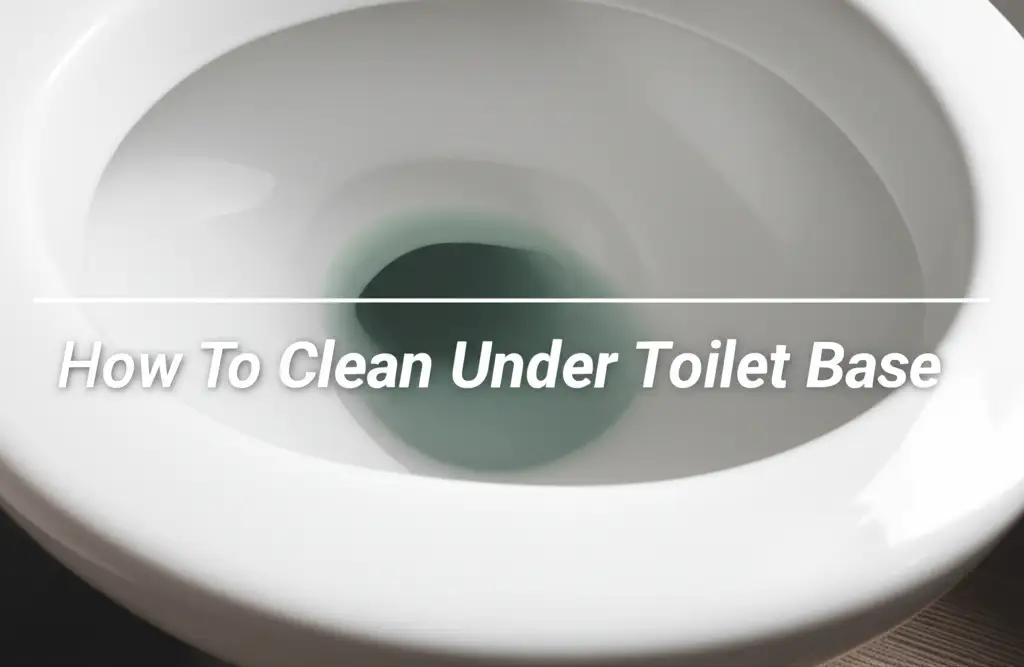· Bathroom Cleaning · 18 min read
How To Clean Black Stuff In Toilet Bowl

How To Clean Black Stuff In Toilet Bowl
Finding unsightly black stuff in your toilet bowl can be quite frustrating. It makes your bathroom feel less clean, no matter how much effort you put into other areas. This stubborn discoloration is more than just an aesthetic problem; it often signals underlying issues. Understanding what causes this black build-up is the first step. Then, you can choose the right cleaning method to banish it for good.
Many homeowners face this common issue. You might wonder if it is mold, mildew, or something else entirely. The good news is that cleaning black stuff in your toilet bowl is manageable with the right tools and techniques. This guide gives you clear steps and proven methods. We cover everything from identifying the problem to preventing its return. Get ready to restore your toilet’s sparkle and maintain a fresh, hygienic bathroom environment.
Takeaway:
- Identify the cause of black stains to choose the right cleaning method.
- Use natural cleaners like vinegar and baking soda for common issues.
- Apply stronger chemical cleaners for persistent black mold or mineral deposits.
- Employ physical scrubbing tools for tough, stuck-on grime.
- Implement regular cleaning habits and good ventilation to prevent future build-up.
Black stuff in your toilet bowl often comes from mold, mildew, or mineral deposits from hard water. To clean it, apply a specialized toilet bowl cleaner or a mixture of vinegar and baking soda. Let it sit for at least 30 minutes. Scrub thoroughly with a stiff-bristled toilet brush. Rinse by flushing.
Understanding the Black Stuff: What Causes It?
When you spot black stuff in your toilet bowl, your first thought might be mold. While mold is a common culprit, it is not the only one. Many factors can contribute to these dark stains. Knowing the source helps you pick the most effective cleaning strategy. Let’s look at the main reasons why your toilet bowl turns black.
One common reason is black mold or mildew. Toilets are damp, dark places, especially under the rim and in the trap. These conditions are ideal for mold and mildew growth. Black mold, specifically Stachybotrys chartarum, can appear as slimy black patches. Mildew looks like a powdery or fuzzy black film. Both thrive on moisture and organic matter. Regular cleaning often prevents these issues. If left untreated, they can spread and become harder to remove. Poor ventilation in the bathroom makes mold growth more likely.
Another significant cause is mineral deposits from hard water. If you live in an area with hard water, your water contains high levels of minerals like iron, manganese, and magnesium. These minerals settle and react with the toilet’s porcelain. They create a rough surface where other substances can stick. Iron can lead to reddish-brown stains, but manganese can cause dark brown or black stains. Over time, these mineral stains build up and look like black grime. These deposits are tough to remove with regular toilet cleaners. They often need acidic solutions to dissolve them.
Finally, bacteria and biofilm can also contribute to black discoloration. Bacteria naturally occur in water and can form a slimy film. This film, called biofilm, traps dirt, mold spores, and mineral particles. This creates a dark, often slimy, residue. This is common in parts of the toilet that stay wet all the time, such as the water line or inside the S-bend. This type of black stuff might feel slick to the touch. Regular scrubbing helps disrupt biofilm formation. Understanding these causes helps you tackle the problem head-on.
Essential Cleaning Supplies for Black Stains
Before you start cleaning, gather all the tools and products you will need. Having everything ready makes the cleaning process smoother and more efficient. Using the right supplies ensures you can effectively tackle different types of black stains. This preparation saves you time and effort. It also helps achieve a truly clean toilet bowl.
First, you will need a good toilet brush. Choose one with stiff bristles. This type of brush helps scrub away stubborn stains and build-up. A brush with an under-rim attachment is especially useful. It helps reach those hidden spots where mold and grime love to hide. Make sure your toilet brush is clean. A dirty brush can spread bacteria instead of removing them. Consider replacing old, worn-out brushes for better cleaning power.
Next, prioritize protective gear. Always wear rubber gloves to protect your hands from harsh chemicals and bacteria. If you use strong cleaners, you might also want to wear safety goggles. These protect your eyes from splashes. Ensure the bathroom is well-ventilated by opening a window or turning on an exhaust fan. Good ventilation helps disperse fumes from cleaning products. Your personal safety is always important during any cleaning task.
You will also need cleaning agents. This includes both natural options and chemical solutions. For natural cleaning, have white vinegar and baking soda on hand. These are excellent for mild stains and general maintenance. For tougher black stuff, you may need a specialized toilet bowl cleaner. Look for products designed to remove mold, mildew, and mineral deposits. You might also consider a pumice stone for extremely stubborn mineral stains. A spray bottle can be useful for applying natural solutions. A bucket of hot water is also handy for dissolving certain cleaners or for rinsing. Having these items ready ensures you can clean black stuff in your toilet bowl effectively and safely.
Natural Cleaning Solutions: Eco-Friendly Approaches
Using natural cleaning solutions is a great way to clean black stuff in your toilet bowl without harsh chemicals. These methods are safer for your family, pets, and the environment. They often work just as well for common black stains caused by mold, mildew, or minor mineral build-up. You likely already have these ingredients in your pantry, making them convenient and cost-effective.
Vinegar and Baking Soda Method: This is a powerful combination for many cleaning tasks. Baking soda acts as a gentle abrasive. Vinegar’s acidity helps dissolve mineral deposits and kills mold. Start by flushing the toilet to empty most of the water. This allows the cleaners to work directly on the stains. Sprinkle about half a cup of baking soda directly into the toilet bowl, focusing on the black areas. Let it sit for 15-20 minutes. You can learn more about how baking soda and vinegar work together for cleaning in other parts of your home, like when you clean your dishwasher with vinegar and baking soda.
After the baking soda has settled, pour two cups of white vinegar into the bowl. The mixture will fizz and bubble. This reaction helps lift and break down the stains. Let this solution sit for at least 30 minutes, or even overnight for stubborn black stuff. If you have stains under the rim, pour some vinegar directly onto those spots. You can also use a spray bottle to apply vinegar.
Once the soaking time is over, take your toilet brush and scrub the entire bowl thoroughly. Pay extra attention to the black stained areas. The baking soda provides the scrubbing power, while the vinegar dissolves the grime. Flush the toilet multiple times to rinse away the solution and the loosened black stuff. For continued maintenance, consider using this method weekly. This helps keep black stains from returning. Similar principles apply when you clean your washing machine with baking soda and vinegar, showing their versatility.
Borax Method: Borax is another natural mineral with excellent cleaning properties. It helps sanitize and remove stains. To use borax, sprinkle half a cup into the toilet bowl, focusing on the black areas. Let it sit for at least an hour, or overnight for very tough stains. Then, scrub the bowl thoroughly with your toilet brush. Flush to rinse. For added power, you can combine borax with a small amount of white vinegar. Always ventilate the bathroom when using borax. These natural solutions provide effective ways to clean black stuff in your toilet bowl, keeping your bathroom fresh and chemical-free.
Heavy-Duty Cleaning: When You Need Stronger Agents
Sometimes, natural cleaning solutions are not enough to remove persistent black stuff in your toilet bowl. This is especially true for severe black mold infestations or very old, stubborn mineral deposits. In these cases, you might need to use stronger chemical cleaners. These products are designed to break down tough grime quickly and effectively. Always remember to prioritize safety when working with these powerful substances.
Using Commercial Toilet Bowl Cleaners: Many commercial toilet bowl cleaners are specifically formulated to tackle tough stains, including black mold and mineral build-up. These cleaners often contain strong acids or bleaching agents. Look for products that advertise “kills mold” or “removes rust and lime.” To use these cleaners, carefully read the instructions on the product label. Most recommend applying the cleaner directly under the rim and onto visible stains. Let the product sit for the recommended time, usually 5-15 minutes. This allows the chemicals to penetrate and dissolve the black stuff.
After the soaking period, scrub the entire bowl thoroughly with a toilet brush. Pay special attention to the black areas. The cleaner helps loosen the grime, making it easier to scrub away. Flush the toilet multiple times to ensure all cleaner residue and loosened black stuff are gone. Always wear rubber gloves when handling commercial cleaners. Ensure your bathroom is very well-ventilated. Open windows and turn on the exhaust fan to prevent inhaling strong fumes. Do not mix different commercial cleaners together, especially bleach-based and acid-based ones, as this can create dangerous gases.
Bleach for Black Mold: If the black stuff is definitively mold or mildew, bleach can be highly effective. Bleach kills mold spores and lightens stains. To use bleach, pour about one cup of liquid chlorine bleach directly into the toilet bowl. Make sure to get it on all the black areas, including under the rim. Let the bleach sit for at least 30 minutes, or up to several hours for very tough mold. Do not use bleach if you have recently used an acid-based cleaner, like some commercial toilet cleaners or vinegar, as this creates harmful chlorine gas.
After the bleach has had time to work, scrub the bowl thoroughly with your toilet brush. Flush the toilet several times to rinse completely. Always ensure the bathroom is well-ventilated when using bleach. Never mix bleach with other cleaning products, especially those containing ammonia or acids. While bleach is strong, it is primarily for killing mold and whitening. It may not fully remove mineral stains. For those, specialized mineral deposit removers are better. These stronger agents help you effectively clean black stuff in your toilet bowl when natural methods fall short.
Tackling Stubborn Stains: Advanced Techniques
Sometimes, even strong chemical cleaners might not completely remove all the black stuff in your toilet bowl. This is often the case with long-standing mineral deposits or deeply embedded grime. When faced with these truly stubborn stains, you need to employ more advanced techniques and specialized tools. These methods involve a bit more elbow grease or specific acidic solutions designed to break down mineral build-up.
One highly effective tool for stubborn mineral stains is a pumice stone. A pumice stone is a natural abrasive that is hard enough to scrub away mineral deposits but soft enough not to scratch porcelain. Before using it, always wet both the pumice stone and the toilet bowl. A dry pumice stone can scratch the porcelain. Gently rub the pumice stone directly on the black mineral stains. You will notice a paste forming as you scrub; this is normal. Continue scrubbing until the stains disappear. This technique works wonders on hard water rings and black mineral streaks that no amount of chemical cleaning seems to touch. Rinse the area frequently to check your progress. This method is physical and requires some effort, but the results are often dramatic.
For very tough mineral deposits, especially those from hard water, you might need a dedicated acidic cleaner specifically for rust and lime. Products containing hydrochloric acid or phosphoric acid are formulated to dissolve these mineral bonds. Look for cleaners labeled as “CLR” (Calcium, Lime, Rust) or similar. These are different from standard toilet bowl cleaners. Always follow the product instructions very carefully. Pour the cleaner into the bowl, ensuring it covers all the black mineral stains. Allow it to sit for the recommended time, which can vary from a few minutes to an hour, depending on the product and stain severity.
After the soaking time, scrub the stained areas with your toilet brush. The acidic cleaner should have softened the deposits, making them easier to remove. Flush the toilet thoroughly to rinse away the cleaner and dissolved grime. Remember the crucial safety precautions: wear heavy-duty rubber gloves and eye protection. Ensure the bathroom is extremely well-ventilated. Never mix these acidic cleaners with bleach or any other cleaning products. Doing so can release toxic fumes. If you have problems with hard water stains on other bathroom surfaces, like shower glass, you might find useful tips on how to clean hard water stains on shower glass. By using these advanced techniques, you can effectively clean black stuff in your toilet bowl, even the most persistent and embedded stains.
Preventing Black Stuff: Keeping Your Toilet Clean Longer
Once you have successfully cleaned black stuff in your toilet bowl, you will want to keep it that way. Prevention is always easier than cure. Regular maintenance and a few simple habits can significantly reduce the chances of black mold, mildew, and mineral deposits returning. A proactive approach saves you time and effort in the long run. It also ensures your toilet remains consistently clean and hygienic.
Regular Cleaning Routine: The most effective way to prevent black stuff is to clean your toilet regularly. Aim for a quick clean at least once a week. This involves a simple scrub with a toilet brush and a mild toilet cleaner. Focus on the water line, under the rim, and inside the bowl. Regular scrubbing removes nascent mold spores and mineral particles before they can accumulate and form visible stains. Even a five-minute weekly clean can make a huge difference. This routine prevents biofilm from establishing itself, which often forms the base for darker stains.
Improve Bathroom Ventilation: Black mold and mildew thrive in damp, humid environments. Poor ventilation in your bathroom creates ideal conditions for their growth. After showering or bathing, run your exhaust fan for at least 15-20 minutes. If you do not have an exhaust fan, open a window to allow fresh air to circulate. Keeping the bathroom door open when not in use can also help reduce humidity levels. Reducing moisture in the air helps dry out the toilet bowl faster. This makes it less hospitable for mold and mildew to grow.
Address Hard Water Issues: If hard water is the primary cause of black mineral stains, consider solutions to treat your home’s water. A whole-house water softener can significantly reduce mineral build-up not just in your toilet, but throughout your plumbing system and appliances. While a water softener is a larger investment, it provides a permanent solution to hard water problems. For a less drastic approach, you can use toilet bowl tablets that contain chelating agents. These agents help prevent mineral deposits from adhering to the porcelain. However, these tablets should be used with caution, as some can damage toilet components over time.
Regularly Flush Unused Toilets: Toilets in guest bathrooms or those used infrequently can develop black mold or biofilm faster. Stagnant water provides a perfect breeding ground. If you have an unused toilet, flush it at least once every few days. This refreshes the water in the bowl and trap. It also helps remove any circulating mold spores or mineral particles. This simple action disrupts the conditions that favor black stuff growth. By adopting these preventive measures, you can keep your toilet bowl sparkling clean and free from black stuff, ensuring a fresh bathroom environment.
Safety First: Important Precautions
When you clean black stuff in your toilet bowl, always prioritize safety. Many cleaning products, both natural and chemical, can pose risks if not used correctly. Taking proper precautions protects your health and prevents accidents. These simple steps ensure your cleaning process is effective without putting yourself or others in harm’s way. Your well-being should always be the top concern.
First, wear appropriate personal protective equipment (PPE). This includes rubber gloves. Gloves protect your skin from irritating chemicals and harmful bacteria. For stronger chemical cleaners, it is wise to wear safety goggles. These prevent splashes from entering your eyes. Even natural cleaners like vinegar can irritate skin or eyes in concentrated forms. Always assume chemicals can cause harm and dress accordingly.
Second, ensure proper ventilation. This is crucial, especially when using strong chemical cleaners like bleach or acid-based products. Strong fumes can irritate your respiratory system, eyes, and throat. Open a window in the bathroom. Turn on the exhaust fan. If possible, keep the bathroom door open. Good airflow helps disperse chemical fumes. This makes the air safer to breathe. Never clean in a poorly ventilated area, especially with strong products.
Third, never mix different cleaning chemicals. This is perhaps the most important safety rule. Combining certain products can create toxic gases. For example, mixing bleach with ammonia (found in many all-purpose cleaners) creates chloramine gas. Mixing bleach with acids (like vinegar or some toilet bowl cleaners) creates chlorine gas. Both gases are highly dangerous and can cause severe respiratory problems or even death. Always use one cleaner at a time. Rinse the toilet thoroughly before applying a different type of cleaner. If you are unsure about the chemical composition, err on the side of caution and do not mix.
Finally, keep cleaning products out of reach of children and pets. Store them in a high cabinet or a locked cupboard. Always put lids back on tightly after use. Dispose of empty containers properly according to local guidelines. If an accident occurs, such as skin contact or ingestion, read the product label for first-aid instructions. If necessary, seek immediate medical attention. By following these safety guidelines, you can effectively clean black stuff in your toilet bowl while ensuring a safe environment for everyone.
FAQ Section
Q1: What exactly is the black stuff in my toilet bowl? A1: The black stuff in your toilet bowl is usually a combination of black mold, mildew, and mineral deposits. Hard water contains minerals like manganese that can create black stains. Biofilm, a slimy layer of bacteria and organic matter, also contributes to the dark discoloration. It thrives in damp toilet environments.
Q2: Can I use bleach to clean black stuff in my toilet? A2: Yes, you can use bleach for black mold or mildew stains. Pour about one cup of bleach into the bowl, let it sit for 30 minutes, then scrub and flush. Be very careful. Never mix bleach with other cleaners, especially ammonia or acid-based products like vinegar, as this creates dangerous toxic gases. Ensure good ventilation.
Q3: Are natural cleaners effective for black toilet stains? A3: Natural cleaners like white vinegar and baking soda are very effective for mild to moderate black stains. Baking soda provides abrasive action. Vinegar’s acidity dissolves mineral deposits and kills some mold. For very stubborn or old stains, you might need a stronger commercial cleaner or a pumice stone.
Q4: How can I prevent black stuff from returning to my toilet? A4: To prevent black stuff, clean your toilet regularly, at least once a week. Improve bathroom ventilation by using an exhaust fan or opening windows to reduce humidity. If you have hard water, consider using a water softener or special tablets that prevent mineral buildup. Flush unused toilets regularly.
Q5: What is the best way to remove tough black hard water stains? A5: For tough black hard water stains, a pumice stone works well. Wet the stone and the toilet bowl, then gently scrub the stains. For chemical solutions, use an acid-based cleaner specifically designed for calcium, lime, and rust (CLR). Always follow product instructions and wear protective gear.
Q6: Is black stuff in the toilet bowl harmful? A6: While not always immediately harmful, black mold (Stachybotrys chartarum) can cause respiratory issues in sensitive individuals. Biofilm and general grime harbor bacteria, which is unhygienic. Cleaning it removes these potential health concerns and improves overall bathroom cleanliness. Regular cleaning is important for hygiene.
Conclusion
Tackling black stuff in your toilet bowl might seem like a daunting task, but with the right knowledge and tools, you can restore your toilet’s pristine appearance. We have explored the common culprits, from stubborn black mold and mildew to relentless hard water mineral deposits. We discussed effective cleaning strategies, ranging from eco-friendly natural solutions like vinegar and baking soda to powerful commercial cleaners for tougher challenges. We also covered advanced techniques such as using a pumice stone for ingrained stains.
Remember that prevention is your best defense. Regular cleaning, ensuring proper bathroom ventilation, and addressing hard water issues can significantly reduce the chances of these unsightly stains returning. Always prioritize safety by wearing protective gear, ensuring good ventilation, and never mixing different cleaning chemicals. By following these practical steps, you can keep your toilet bowl sparkling clean and maintain a hygienic bathroom environment. Do not let black stuff in your toilet bowl diminish your home’s cleanliness. Take action today and enjoy a fresher, cleaner bathroom.
- toilet cleaning
- black stains
- mold removal
- hard water
- bathroom hygiene
- cleaning tips




